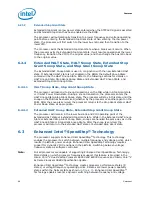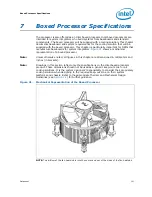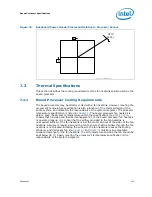
Thermal Specifications and Design Considerations
90
Datasheet
5.3
Thermal Diode
The processor incorporates an on-die PNP transistor where the base emitter junction is
used as a thermal "diode", with its collector shorted to ground. A thermal sensor
located on the system board may monitor the die temperature of the processor for
thermal management and fan speed control.
, and
provide
the "diode" parameter and interface specifications. Two different sets of "diode"
and
. The Diode Model parameters (
apply to traditional thermal sensors that use the Diode Equation to determine the
processor temperature. Transistor Model parameters (
) have been added to
support thermal sensors that use the transistor equation method. The Transistor Model
may provide more accurate temperature measurements when the diode ideality factor
is closer to the maximum or minimum limits. This thermal "diode" is separate from the
Thermal Monitor's thermal sensor and cannot be used to predict the behavior of the
Thermal Monitor.
T
CONTROL
is a temperature specification based on a temperature reading from the
thermal diode. The value for T
CONTROL
will be calibrated in manufacturing and
configured for each processor. When T
DIODE
is above T
CONTROL
, then T
C
must be at or
below T
C_MAX
as defined by the thermal profile in
; otherwise, the processor
temperature can be maintained at T
CONTROL
(or lower) as measured by the thermal
diode.
NOTES:
1.
Intel does not support or recommend operation of the thermal diode under reverse bias.
2.
Characterized across a temperature range of 50 – 80 °C.
3.
Not 100% tested. Specified by design characterization.
4.
The ideality factor, n, represents the deviation from ideal diode behavior as exemplified by
the diode equation:
I
FW
= I
S
* (e
qV
D
/nkT
–1)
where I
S
= saturation current, q = electronic charge, V
D
= voltage across the diode,
k = Boltzmann Constant, and T = absolute temperature (Kelvin).
5.
The series resistance, R
T
, is provided to allow for a more accurate measurement of the
junction temperature. R
T
, as defined, includes the lands of the processor but does not
include any socket resistance or board trace resistance between the socket and the
external remote diode thermal sensor. R
T
can be used by remote diode thermal sensors
with automatic series resistance cancellation to calibrate out this error term. Another
application is that a temperature offset can be manually calculated and programmed into
an offset register in the remote diode thermal sensors as exemplified by the equation:
T
error
= [R
T
* (N–1) * I
FWmin
] / [nk/q * ln N]
where T
error
= sensor temperature error, N = sensor current ratio, k = Boltzmann
Constant, q = electronic charge.
Table 33.
Thermal “Diode” Parameters using Diode Model
Symbol
Parameter
Min
Typ
Max
Unit
Notes
I
FW
Forward Bias Current
5
—
200
µA
1
n
Diode Ideality Factor
1.000
1.009
1.050
-
2, 3, 4
R
T
Series Resistance
2.79
4.52
6.24
Ω
2, 3, 5
Содержание CORE 2 DUO E4000 - 3-2008
Страница 8: ...8 Datasheet ...
Страница 10: ...10 Datasheet ...
Страница 36: ...Electrical Specifications 36 Datasheet ...
Страница 38: ...Package Mechanical Specifications 38 Datasheet Figure 9 Processor Package Drawing Sheet 1 of 3 ...
Страница 39: ...Datasheet 39 Package Mechanical Specifications Figure 10 Processor Package Drawing Sheet 2 of 3 ...
Страница 40: ...Package Mechanical Specifications 40 Datasheet Figure 11 Processor Package Drawing Sheet 3 of 3 ...
Страница 46: ...Package Mechanical Specifications 46 Datasheet ...
Страница 100: ...Features 100 Datasheet ...
Страница 110: ...Boxed Processor Specifications 110 Datasheet ...
Страница 122: ...Debug Tools Specifications 122 Datasheet ...















































